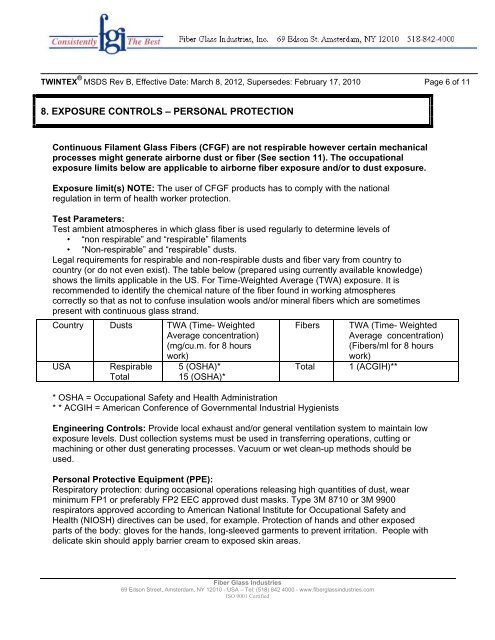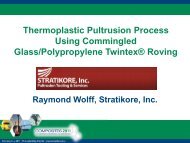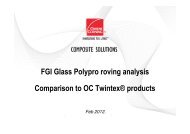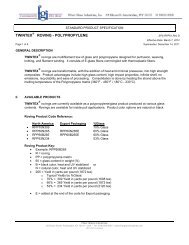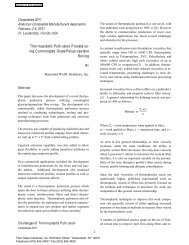Twintex® MSDS - Fiber Glass Industries, Inc
Twintex® MSDS - Fiber Glass Industries, Inc
Twintex® MSDS - Fiber Glass Industries, Inc
Create successful ePaper yourself
Turn your PDF publications into a flip-book with our unique Google optimized e-Paper software.
TWINTEX ® <strong>MSDS</strong> Rev B, Effective Date: March 8, 2012, Supersedes: February 17, 2010 Page 6 of 11<br />
8. EXPOSURE CONTROLS – PERSONAL PROTECTION<br />
Continuous Filament <strong>Glass</strong> <strong>Fiber</strong>s (CFGF) are not respirable however certain mechanical<br />
processes might generate airborne dust or fiber (See section 11). The occupational<br />
exposure limits below are applicable to airborne fiber exposure and/or to dust exposure.<br />
Exposure limit(s) NOTE: The user of CFGF products has to comply with the national<br />
regulation in term of health worker protection.<br />
Test Parameters:<br />
Test ambient atmospheres in which glass fiber is used regularly to determine levels of<br />
• “non respirable” and “respirable” filaments<br />
• “Non-respirable” and “respirable” dusts.<br />
Legal requirements for respirable and non-respirable dusts and fiber vary from country to<br />
country (or do not even exist). The table below (prepared using currently available knowledge)<br />
shows the limits applicable in the US. For Time-Weighted Average (TWA) exposure. It is<br />
recommended to identify the chemical nature of the fiber found in working atmospheres<br />
correctly so that as not to confuse insulation wools and/or mineral fibers which are sometimes<br />
present with continuous glass strand.<br />
Country Dusts<br />
USA Respirable<br />
Total<br />
TWA (Time- Weighted<br />
Average concentration)<br />
(mg/cu.m. for 8 hours<br />
work)<br />
5 (OSHA)*<br />
15 (OSHA)*<br />
* OSHA = Occupational Safety and Health Administration<br />
* * ACGIH = American Conference of Governmental Industrial Hygienists<br />
<strong>Fiber</strong>s TWA (Time- Weighted<br />
Average concentration)<br />
(<strong>Fiber</strong>s/ml for 8 hours<br />
work)<br />
Total 1 (ACGIH)**<br />
Engineering Controls: Provide local exhaust and/or general ventilation system to maintain low<br />
exposure levels. Dust collection systems must be used in transferring operations, cutting or<br />
machining or other dust generating processes. Vacuum or wet clean-up methods should be<br />
used.<br />
Personal Protective Equipment (PPE):<br />
Respiratory protection: during occasional operations releasing high quantities of dust, wear<br />
minimum FP1 or preferably FP2 EEC approved dust masks. Type 3M 8710 or 3M 9900<br />
respirators approved according to American National Institute for Occupational Safety and<br />
Health (NIOSH) directives can be used, for example. Protection of hands and other exposed<br />
parts of the body: gloves for the hands, long-sleeved garments to prevent irritation. People with<br />
delicate skin should apply barrier cream to exposed skin areas.<br />
<strong>Fiber</strong> <strong>Glass</strong> <strong>Industries</strong><br />
69 Edson Street, Amsterdam, NY 12010 - USA – Tel: (518) 842 4000 - www.fiberglassindustries.com<br />
ISO 9001 Certified


